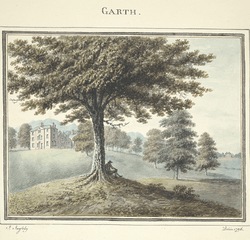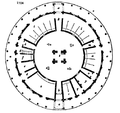Garth (Guilsfield)
| Garth, Guilsfield | |
|---|---|
|
Garth, Guilsfield in 1796 | |
| Location | Guilsfield, Montgomeryshire, Wales |
| Coordinates | 52°41′16″N 3°09′52″W / 52.687657°N 3.164550°WCoordinates: 52°41′16″N 3°09′52″W / 52.687657°N 3.164550°W |
| Built | c.1800 for Devereux Mytton. |
| Demolished | 1947 |
| Architectural style(s) | Strawberry Hill Gothic |
 Location in Montgomeryshire | |
Garth was an important and historic house in the township of Garth in Guilsfield in Montgomeryshire. In the 18th century it became the home of the Mytton family who had originally been Shrewsbury mercers, who derived their wealth from the Montgomeryshire weaving industry. They had settled at Pontyscoweryd in Meifod and at Halston in Shropshire. The most famous members of the family were General Mytton, the Parliamentary Commander in the Civil War in the Marches and “Mad Jack Mytton”, the eccentric 19th. century squire of Halston. Probably at the end of the 18th. century a grandiose rebuilding scheme was started by Devereux Mytton. His grandson, Richard Mytton, who inherited Garth in 1809 at the age of 23 was faced with financial problems. The Myttons were never able to afford to live in style in this house. It is often stated that it cost nearly £100,000 to build[1] The family continued to own the house until 1947, when it was finally demolished.[2]
Earlier History
Garth is a historic site of considerable antiquity. It may have been the home of Sir Griffith Vychan who had fought at Agincourt in 1415,[3] and was descended from Brochwel Ysgithrog, Prince of Powys. Humphrey Wynn of Garth who was living in 1569 was fourth in descent from Gruffydd Fychan. His grandson was Brochwel Wynn, whose daughter Dorothy, was to marry Richard Mytton of Pontescowryd in Meifod in 1717.[4] With this marriage, Garth passed to the Mytton family. Richard Mytton rebuilt the front portion of the house in brick with fashionable Georgian Venetian windows. Richard Mytton was High Sheriff of Montgomeryshire in 1730. His son Devereux Mytton was to live at Garth until his death in 1809. It appears that Devereux Mytton had already embarked on an ambitious building programme at Garth before his grandson Richard Mytton inherited Garth, at the age 23, in 1809[5] His grandson Richard probable completed the stable block, but found himself faced with considerable debts; and the families finances was not helped by the collapse of Mytton's Bank in Welshpool. Richard Mytton left for France in 1811 to avoid bankruptcy, and, by the skilful use of Trusts, the family managed to retain Garth and most of its estate.[6] After the death of Richard Mytton in 1828, Garth continued to be lived in by Richard's wife Charlotte until about 1850, when her son Richard Herbert Mytton, who had joined the Bengal Civil Service returned from India. In 1856 he became High Sheriff of Montgomeryshire. His son Devereux Herbert Mytton succeeded him on his death in 1869.[7]
The Garth Myth
It would appear that in 1811 the Richard Mytton had placed much of his property into a trust as, he wishes to go abroad, apparently to Boulonge, to avoid bankruptcy and the debtors' prison.[8] Presumably, in much straitened circumstances, he had returned to England by 1818, when he was admitted to St. John's College, Cambridge. He gained a Bachelor of Laws Degree in 1820 and was ordained by the Bishop of Hereford, and was curate of Trelystan from 1820-6.[9] He left for India in 1826 and in 1827 the Rev. Richard Mytton, late of Garth, now of Calcutta, East Indies had to make over further lands to the commissioners of taxes in consideration of a large sum of money owed to Crown [10] Mytton died in February 1828, and there is a memorial in Guilsfield Church describing him as chaplain of Barrackpore, Bengal and to the Governor General of India. At the time of his death on 23rd Feb 1828, the Rev Richard Mytton was on board the Palmyra, returning from India to England. The suggestion that Mytton made a fortune in India, which he used to fund the building of Garth appears to be a myth. There is also no reason why the architecture of Garth should have been built in an Islamic style, as often stated, when Mytton did not go to India until 16 years after Garth had been built.
The Georgian House

In July 1786 Thomas Pennant passed the house on a tour through Montgomeryshire. He records The Country from Poole (Welshpool) towards Llanymynach is most beautifully broken into gentle rising, prettily wooded. …..Pass by the Garth, the seat of Devereux Mytton, Esq. Pennant had a particular interest as he was related to William Mytton of Halston, an antiquary, whose notes he used extensively. Pennant in 1796 commissioned John Ingleby to produce a watercolour of Aberbechan Hall, which presumably he intended to use as an illustration for a future edition of the Tour in Wales. This watercolour, which is now in the collections of the National Library of Wales, appears to be the only surviving depictions of the Hall, shown on a hill in the wooded countryside.[11] Ingleby's watercolour shows the house of 1717, had been placed in front of earlier buildings, possibly timber-framed of the Wynn family.
The Architecture of Garth

It appears that the rebuilding of Garth had started before 1809, as Loudon notes that the commission for the riding house, or stables was for Col. Mytton[12] (Devereux Mytton). It is often stated that the architect was John C. Loudon,[13] but there is no documentary evidence to suggest that he did more than a preliminary sketch and plan for a stable block and circular Riding school [14] for the stables, which was rejected in favour of another unnamed architect.
Garth is built in Gothic Revival style with decorative diagonal buttresses and graceful crocketed spires. The smooth, rather bare walls were faced with yellow-grey stone, probably from the Cefn quarry near Minera. The windows have flat ogee profiles and arched merlons with ball-finials. From the centre of the south front the saloon projected - turreted, and with a vast traceried window, above which, the crenellation rose and fell. A veranda along this front was wrapped round the octagonal bows at either end. There is a resemblance to Thomas Johnes’ Hafod in Ceredigion, which was gothicised by John Nash (architect) in 1791-4.[15] In particular, the top lantern tower at Hafod over library is very similar to the lantern tower over the stairs at Garth. The design of Garth is conservative and dates back to Horace Walpole's Strawberry Hill, with very similar interior fan-vaulting and plaster-work to that at Strawberry Hill, while the columns of veranda and a exterior balcony are reminiscent of the work of the Shrewsbury architect Thomas Farnolls Pritchard. It looks as if the plans for Garth had been prepared sometime before, and it is possible that the re-building of Garth for Devereux had started in the later years of the 18th century, with the Riding House being added in 1809.
The design of the Riding House or Stables
The ground plan of these stables was designed by us (Loudon) in 1809 for the late Col. Mytton of Garth, Montgomeryshire; and it is proper to observe the principal object in view was, to provide accommodation for breeding and breaking of a superior description of riding horses. The situation on which these stables were placed was the summit of an elevated knoll, protruding from the side of a hill; and their effect was remarkably good from all the surrounding country. The elevation actually executed from our design was different from either of those now given (figs 1702 and 1703), and, we need not say, much inferior; the later having been suggested and sketched for us by Barry, and prepared for the engraver by Mr Lamb. Fig 1702 is in the Italian style and fig 1703 is in Tudor Gothic. The form of a riding-house is generally that of a parallelogram:though that at Brighton, some in London and the veranda at Garth ...are circular.’’
John Claudius Loudon ‘’ Encyclopædia of Cottage, Farm, and Villa Architecture and Furniture.’’ Longmans, London. pp965 and 966
1839

The plans for the circular Riding House were derived from Porden's Riding House at the Royal Pavilion, Brighton (1804-8).[16] In 1834 Loudon published two rejected designs for the Garth Riding House, one of which he says was by Charles Barry and the other by himself[17] The designs that were actually built are very different to Loudons's design and have been in executed to match the decorative features of the presumably earlier main house. The stables were circular, 84 ft in diameter, with triangular merlons, ogee windows again, and with an external covered passage (with cast-iron stations) all round, where horses – even with carriages - could be exercised out of the rain. The loose-boxes were arranged radially, in a round-house. Today, only the mid-C19 brick farm buildings survive. The arrangement is a huge three-sided courtyard, entered between barns at the top; at the ends of the arms are two cottages.
Gallery: Loudons plans for the Riding House
|
Gallery: Garth at the time of demolition 1947
|
|
Literature
- Humphreys M The Crisis of Community: Montgomeryshire 1680-1815, University of Wales Press, Cardiff, 1996.
- Lloyd, T.,(1986) The Lost houses of Wales, p. 41.
- Pughe, G. R.(Rev), (1890), Mytton of Garth, Montgomeryshire Collections, Vol 24, 277-294.
- Scourfield R and Haslam R, (2013) Buildings of Wales: Powys; Montgomeryshire, Radnorshire and Breconshire, 2nd edition, Yale University Press, p. 133-134.
References
- ↑ 'Humphreys", (1996), 116, gives the cost as £30,000 , but that Richard Mytton on inheriting also spent £43,000 on the purchase of Trefnannau and other local estates.
- ↑ Lloyd, T.,(1986) The Lost houses of Wales, pp. 38-9.
- ↑ Williams G. (1998). Sir Gruffydd Fychan (?-1447) Montgomeryshire Collections Vol. 86, p17-28
- ↑ Burke J (1835), A Genealogical and Heraldic History of the Commoners of Great Britain, pp. 523-5
- ↑ "Loudon", (1839), 965-966
- ↑ Documentation in the Shropshire Record Office. There was also a case in the Court of Chancery in 1834 concerning the Trust's validity
- ↑ Pughe, G. R.(Rev), (1890), Mytton of Garth, Montgomeryshire Collections, Vol 24, 277-294
- ↑ Shropshire Record Office 3766/2/1/68
- ↑ http://venn.lib.cam.ac.uk/Documents/acad/search.html
- ↑ Shropshire Record Office 3766/2/1/69-70).
- ↑ Lloyd, T.,(1986) The Lost houses of Wales, p.38-9
- ↑ Mytton was commissioned into the Royal Montgomeryshire Regiment of Militia in 1766
- ↑ Colvin H. A, (1995), Biographical Dictionary of British Architects 1600–1840, Yale University Press, 3rd edition London, 1995, 624
- ↑ J. C Loudon (1812), Observations on laying out farms in the Scotch manner, applied to England, 105, pl 39. which is reproduced in Wiiam E., (1986), The Historical Farm Buildings of Wales, Donald, Edinburgh,48-9
- ↑ Suggett, R (1995) John Nash Architect in Wales, The Royal Commission on the Ancient and Historical Monuments of Wales, ISBN 1-871184-16-9
- ↑ Colvin H. A, (1995), Biographical Dictionary of British Architects 1600–1840, Yale University Press, 3rd edition London, 1995, 773.
- ↑ The Encyclopedia of Cottage, Farm, Villa Architecture 1834. pp965 -966



